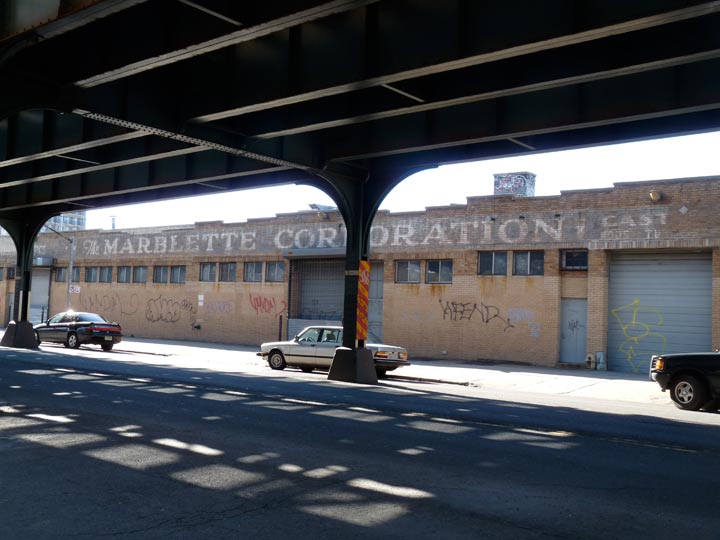
The Astoria Elevated runs from Queensboro Plaza north to Ditmars Boulevard on 31st Street; it has been here since 1917, and was originally run in an unusual joint operation by Brooklyn-Manhattan Transit and Interborough Rapid Transit. The two operators were bifurcated in 1949, when the IRT got the Flushing Line and the BMT got the Astoria, which is why the #7 runs on the Flushing tracks and various letter trains including the B, N, Q and W have all run on the Astoria.
Behind the Astoria Line we see buildings that belonged to the Marblette Corporation, which manufactured industrial plastic (specifically phenolic resins) used in the manufacture of oven handles, cooking tools and decorative door and cabinet parts, and other household items. It competed in the market with Bakelite which had many of the same uses.
Marblette was in Astoria from 1931 to 1982; before that time they had been acquired by one company and then another. The company’s painted signs remain on 30th and 31st Streets north of 38th Avenue.
Check out the ForgottenBook, take a look at the gift shop, and as always, “comment…as you see fit.”
2/19/21


1 comment
The story of the pre-1949 operation on the Astoria and Corona-Flushing elevated is much more complex. Permit me please to go into a bit of detail.
The joint IRT-BMT scheme in Queens was part of the Dual Contracts, a vast subway expansion built between 1913 and 1931 under which NY City financed construction of a whole network of new lines designed to connect Manhattan with The Bronx, Brooklyn, and Queens. The aim was to depopulate overcrowded Manhattan neighborhoods, most notably the Lower East Side, and spread city residents into newer areas the new subways made accessible.
The new routes were divided up primarily on geography – the IRT became the only operator north of 60th Street and in The Bronx. The BRT (became BMT in 1923) was dominant in Brooklyn and Queens. Both firms had parallel routes between Lower Manhattan and 60th Street. Remember that these decisions predate the IND subway, which came later.
The two routes in Northwest Queens – to Astoria and Corona (Flushing after 1928) were operated jointly, because the BMT’s Broadway Subway and 60th Street Tunnel, and the IRT’s Steinway (42nd Street) Tunnel met at Queensboro Plaza. The IRT’s Second Avenue elevated was extended across the Queensboro Bridge to QB Plaza as well.
Queensboro Plaza, as originally built, contained eight tracks and four platforms – basically double the size of today’s station. From there the IRT operated direct services, stopping at today’s combined #7/N station, from the Steinway Tunnel or 2nd Ave. elevated to either Astoria or Corona. The BMT has a separate station on the north side of today’s structure, that closed in 1949 and was removed around 1960. There, its subway trains to and from the Broadway Line (usually originating in Bay Ridge or Coney Island) terminated their runs. Shuttle elevated trains using wooden cars with IRT clearances travelled between QB Plaza and Astoria or Flushing. Vestiges of the old north side structure are still evident today if one stands on Bridge Plaza North facing the bridge entrance.
In 1940 NY City bought out the IRT and BMT and both became divisions of the NY City Board of Transportation, but joint operations to/from Astoria and Flushing continued using the old pattern. Second Ave. El trains on the bridge were eliminated in 1942. In 1949, the Board of Transportation ended the joint operation, and today’s pattern was established. IRT Division trains became the sole province of the Steinway Tunnel-Flushing route. The BMT Division ended its shuttles and began through subway service between Astoria and either Bay Ridge/95th St. or Coney Island, using the familiar Standard and Triplex Cars. The post-1949 arrangement, still in use today, allowed the entire north side platforms and tracks to be closed and later removed. A simplified operation, with the familiar cross-platform #7/N setup still in use today, was established. The six station platforms between 39th Avenue and Ditmars Blvd. were shaved back and lengthened to accommodate the wider and longer BMT trains.
Queensboro Plaza Station continues to have two unique distinctions. It is the only NYC transit station where A Division (IRT) and B Division (BMT-IND) trains meet on opposite sides of a common platform. It is also the only place where the #7 line can connect with the rest of the subway world. That’s why #7 line cars must travel to Coney Island shops for overhaul work, since that line has no physical connection to other IRT routes.